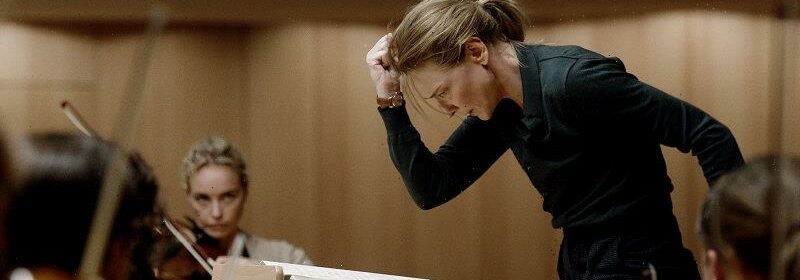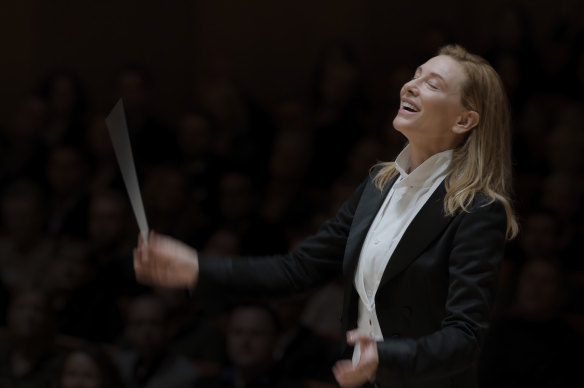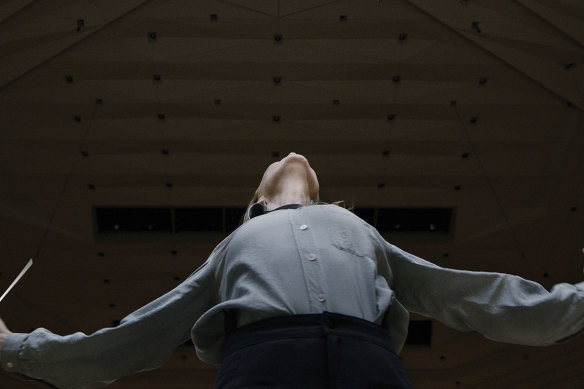I taught Cate Blanchett how to conduct an orchestra

I first met Cate Blanchett four years ago, when we were introduced by a mutual friend. We realised then that we had both worked with theatre director Katie Mitchell who we greatly admired. Fast-forward to 2020 and I was conducting one of Katie’s shows for the Royal Opera House, so I dropped Cate a line to invite her along.
After watching the performance she said: “I can’t believe you’ve been in touch, there’s something I’d love to talk to you about.”
Cate Blanchett in a scene from upcoming movie Tar, in which she plays conductor Lydia Tar.Credit:Focus Features
Cate told me that she had a film coming up, in which she plays a conductor who’s at the height of her career, the first female chief conductor of a prestigious German orchestra. She sent me the screenplay, and I was struck by the way it captured the daily life of a conductor: how we’re constantly moving from theatre to dressing room to car to airport, the urgent practical conversations with musicians in the break, the shifting between different countries and different languages, and the time spent alone, often in contemplation.
That film was Tar, and Cate asked if I could help her with the role.
When I spoke to Todd Field, Tar’s writer and director, he was curious as to how I might work with Cate on conducting. He knew that I teach at the Royal College of Music and I’d worked with Esa-Pekka Salonen and Valery Gergiev – two of today’s exceptional conductors. We discussed the preparation required before getting up on the podium, and it was process and authenticity that interested Todd. He wanted to immerse us in the music-making workspace of Tar, not the glamour, or a romanticised view.
His advice to me was: “I want you and Cate to geek out about conducting!” I appreciated the open brief, as well as his trust, and it was liberating to take a fresh approach with an artist as exceptional as Cate.
My experience in film had been mostly conducting movie soundtracks, but I was fortunate to have coached an actor for a SkyArts program and to have been on-set for the music scenes in the movie, The Death of Stalin.
Once Cate and I began, we set to work on two great masterpieces, Mahler’s Symphony No. 5 and Elgar’s Cello Concerto. Cate plays Lydia Tar, an ambitious musician who’s completing her recording set of the Mahler symphonies for Deutsche Grammophon. It’s the pinnacle of her character’s career, as it would be for any conductor, and the pressure on her is enormous.
Cate and I began by watching conductors on screen, both real and fictional. It felt like the natural place to start, particularly as it was during a lockdown.
The musicians know the piece already – what they require from you is something that isn’t on the page.
We discussed the physical space in which conductors work, and the awareness of the sound the audience receives in the auditorium. I thought carefully about what not to explore with Cate, as much as what we should: with a conducting student, one might build from the basic beating patterns and later move on to matters of interpretation, whereas Cate and I dived straight into the big concepts, and the complexities of directing an orchestra.
We spoke about how conducting at the highest level will look different to, say, a school teacher conducting a choir. There will be endless possibilities of variation: achieving togetherness within the ensemble is not the primary motivation. Orchestras already have the heartbeat of the rhythm; they require something more. There will be critical moments at which they need a special atmosphere, a guiding concept. The musicians know the piece already – what they require from you is something that isn’t on the page.
Cate Blanchett in Tar.Credit:Focus Features via AP
We spoke about the symbolism of conducting gestures; how you can show weight, by turning the wrists inwards; power, with a closed fist; the symbol for vibrato, an insistent shaking of the left hand which mimics how the string players produce the sound; or delicacy through high, light moving fingers.
I encouraged Cate to hold the music in her mind, and have a clear sense of where the different musicians will be placed on the stage in front of her. She came to know where her attention needed to be, with the horns one moment and double basses the next. We studied the pencil markings in the scores owned by great conductors such as Willem Mengelberg and Leonard Bernstein to understand the mental process, sometimes surgical attention to detail, and the scope for interpretation.
Cate instinctively understood that conductors are hyper-aware and able to process a great number of aural cues simultaneously and I quickly realised that her superb acting skills required the same, and much more, from her.
The filming of the conducting scenes was with the wonderful Dresden Philharmonie. Before shooting, Todd, Cate and I rehearsed with its musicians, Nina Hoss, who plays the lead violinist in Tar’s orchestra, and Sophie Kauer, who is a cellist and actress. In private sessions, I’d ask Cate to conduct me as I played a piano reduction, so that she could get a feel for how the orchestra would react.
But nothing can prepare you for the sheer power of an orchestra’s sound, when you stand on the conductor’s podium for the first time. It can throw you off-balance. We compared it to tennis: after the first serve you must follow through – never doubt your initial intention.
There was a section of the Mahler symphony which we decided to beat quickly in three and Cate achieved a beautiful baton pattern, which the woodwind players commented was remarkably clear. When you see her cueing the timpani, or urging the violins to be more expressive, you’re watching genuine communication with the musicians.
And most remarkably, this real conducting was achieved simultaneously with the portrayal of a complex character, someone in physical and emotional pain. I think what Cate achieved was magnificent.
The Telegraph
Find out the next TV, streaming series and movies to add to your must-sees. Get The Watchlist delivered every Thursday.
Most Viewed in Culture
From our partners
Source: Read Full Article

